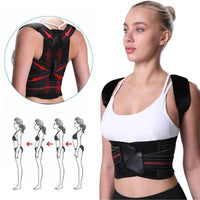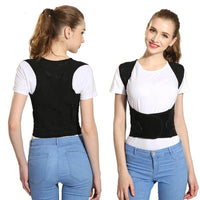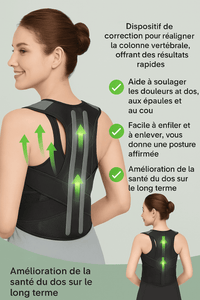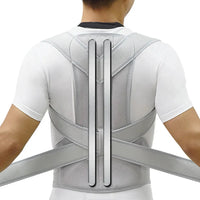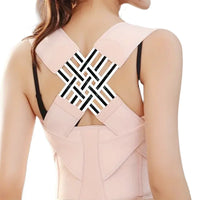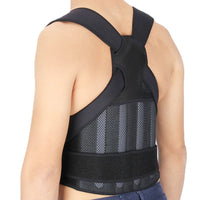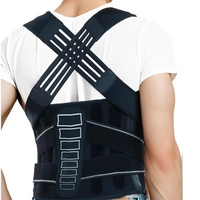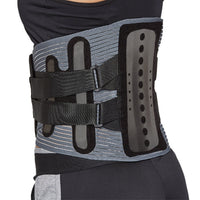Medical straight back corset
⭐ Meilleure vente dans cette collection
Unisex Postural Support
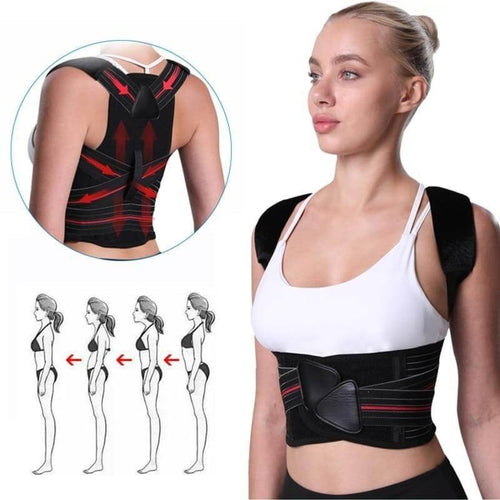
Postural support is an effective solution for relieving pain and regaining healthy posture, thus improving quality of life. In this...
Voir le produitWhat is a medical straight back corset?
A medical corset is a device designed to support and maintain the spine. It is usually made of rigid or semi-rigid materials and is worn around the torso. Its main purpose is to correct bad posture and provide adequate lumbar support.
Origin and evolution
The use of corsets dates back centuries, although those used today are much more sophisticated thanks to technological evolution. Historically, corsets were mainly worn by women for aesthetic reasons. Today, they are designed mainly for medical reasons and benefit from modern materials that increase their effectiveness and comfort.
Materials and construction
Commonly used materials include durable plastics, comfortable breathable fabrics, and sometimes even lightweight metals. This combination not only helps provide a strong back support but also ensures that the corset is comfortable for prolonged use.
The benefits of a medical straight back corset
The benefits of using a back straightener are numerous, ranging from improved posture to reduced pain. Here are some of the main benefits:
- Improved posture: A good medical corset helps to straighten the spine gently and effectively.
- Pain relief: By providing lumbar support, the corset can help relieve pain due to scoliosis, lordosis, and other conditions.
- Injury Prevention: When used correctly, it can prevent injuries related to improper or excessive movements.
- Everyday comfort: Thanks to comfortable breathable materials, you can wear it for longer without discomfort.
Postural correction and support
A posture corrector plays a crucial role in adjusting and supporting your back. By using a medical corset, the body is forced into a correct position, which in the long run turns bad posture into a healthy habit.
Reduction of muscle fatigue
Wearing a back straightener reduces excess muscle tension. When muscles don't have to work as hard to maintain posture, it reduces fatigue and improves overall well-being.
How to Use a Medical Straight Back Corset Correctly
To get the most out of this device, it is important to follow certain usage guidelines. Here are some helpful tips:
Choosing the right model
There are several types of medical corsets. To choose the one that suits you, consult an orthopedic specialist. The professional will be able to assess your specific needs and recommend the appropriate model.
Adjusting the corset correctly
Improper fit can not only decrease the effectiveness of the corset but also cause discomfort. Always follow the manufacturer's instructions to ensure the corset is snug but not too restrictive.
Recommended wearing time
Do not wear the corset all the time. Consult your doctor to find out how long per day you should wear it. Usually, a few hours is enough to achieve the desired results without hindering freedom of movement.
Taking care of your corset
Like any other piece of equipment, corsets require some maintenance. Wash it regularly according to the manufacturer's recommendations to ensure a long life and good level of hygiene.
Common Myths and Realities
There are several misconceptions about medical corsets. Here are some common myths debunked:
"They are not comfortable"
Thanks to technological advances, modern corsets are made from comfortable, breathable materials. They provide excellent support without sacrificing comfort. If you experience discomfort, it may be because the corset was not adjusted correctly.
"They limit all movements"
Although a corset limits some movements to protect the back, it does not hinder all your daily activities. In fact, it promotes correct movements while preventing those that could aggravate injuries.
"You can become addicted"
The purpose of a medical corset is precisely to strengthen the back muscles by gradually changing posture. When used under medical supervision, it does not create dependency but rather encourages better postural hygiene.
Which professionals should you consult?
If you are considering using a medical straight back brace, it is important to consult with qualified professionals. Here are some experts you might see:
General practitioners
Your family doctor can be the first point of contact. They can assess whether you need such a device and refer you to a specialist.
Physiotherapists
A physical therapist can show you how to use the corset effectively in addition to targeted exercises. Their advice is often invaluable in optimizing the benefits of the device.
Specialists in orthopedic devices
These professionals can offer you a variety of models and ensure a personalized fit to precisely meet your physical needs.
Adapting your lifestyle for better posture
Beyond using the corset, changing certain habits can enhance the positive effects. A few simple adjustments can make a big difference.
Regular exercises
Specific exercises, such as stretching and muscle strengthening, can help maintain good posture. Combine these routines with corset use for optimal results.
Office posture
Make sure your workspace is ergonomically set up. Adjust the height of your chair, use good lumbar support, and take regular breaks to walk around and gently stretch your back.
When to avoid using a medical straight back corset?
There are some situations where it is best not to use a medical corset without professional advice. Here are some scenarios where caution is advised:
During pregnancy
Pregnant women should avoid using a corset without first consulting their doctor, as it may affect the growth and development of the fetus.
In case of recent injuries
If you have recently had a serious injury or surgery, wait to get medical advice before starting to use the corset to avoid any complications.
Children and adolescents
Young children and growing adolescents should also consult a specialist before using a corset, as their bodies are still developing.
The acquisition and correct use of a medical straight back corset can have a profound and positive impact on your quality of life. Whether it’s improving your posture, relieving back pain, or providing essential lumbar support, this type of back straightener is an effective solution endorsed by healthcare professionals. So here’s a comprehensive and practical overview of what a medical corset can do. Hopefully, this reading has enlightened you and helped you make an informed decision!
(rating-review=4.9 number-reviews=57)



